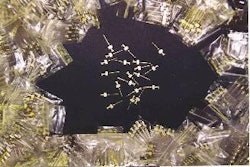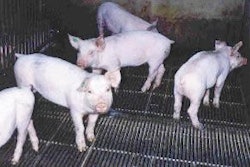
Earlier this year I explained that weaned pigs require to consume dairy products, and more specifically lactose, to thrive. Last month I discussed the quantity of lactose that should be present in the diet to support a satisfactory level of performance by weaners. These were lactose levels required for piglets to grow efficiently under different commercial settings, depending on production goals.
So we have already offered answers on why lactose is desirable in feeds for weaned piglets and how much is needed. The final question always is asked when prices for dairy products are increasing in the international market. Can the lactose content be replaced by alternative sugars?
The simple answer would seem to be: Yes. As early as the start of the 1950's, researchers had identified that although piglets preferred lactose over starch, they could thrive on other simple sugars. Various alternatives have been proven since then to be at least as effective as lactose (a glucose-galactose disaccharide) in promoting piglet growth. The list includes monosaccharides such as glucose, fructose and maltose, also oligosaccharides such as sucrose and maltodextrins.
To this end, we have needed to review the words we use to express dietary specifications for simple sugars. The term lactose equivalent' has become considered appropriate, as it appears that piglets do not have a requirement for lactose per se. Good information is now available for assessing whether each sugar might be employed in weaner diets as a lower-cost replacement for part or all of the lactose content.
Sucrose is the most readily available replacement for lactose. Better known in many households as common table sugar, sucrose is a disaccharide composed of fructose and glucose.
It is well digested and absorbed by young pigs. Fructose is actually absorbed by a gut transportation system quite disparate from that used for glucose and thus is believed to provide a possibility of enhanced energy intake. On the other hand, sucrose is rather poorly digested by piglets that are less than 7-10 days old because they lack specific enzymes responsible for its digestion and metabolism. Therefore, feeding high levels of sucrose (for example, more than 5%) to neonatal pigs invariably leads to diarrhoea and possibly even death from toxicosis.
Nevertheless, pigs rapidly start to produce enzymes essential for digesting and metabolising this sugar. By the second week of life they are capable of producing sufficient quantities to fully digest high levels of sucrose. Work at Kansas State University, USA, has clearly demonstrated that up to 20% sucrose may be used in piglet diets. A word of caution is needed here, however. High levels of sucrose may alter the gastro-intestinal osmotic balance so thatin the absence of proper diet reformulationsimply switching from lactose to sucrose may result in a secretory diarrhoea or the appearance of soft faeces.
Dextrose is the generic term for glucose monohydrate, which in essence is pure glucose with a molecule of water. Consequently, dextrose contains less energy than starch or lactose. Based on recent research results from Purdue University, USA, weaned pigs appear to utilise glucose and dextrose with the same efficacy as their utilisation of lactose.
Anhydrous dextrose is equivalent to pure glucose, but it tends to be more expensive than glucose monohydrate. Both products are highly hygroscopic and agglomerate rapidly during storage. Dextrose usually does not cause secretory diarrhoea if used in levels of around 10% of the complete formula.
Molasses is a co-product of sucrose production. It can be of cane or beet origin. These types share a relatively high nutritive value as long as quality remains constant.
Today, most use of molasses in piglet diets is to enhance palatability and also to facilitate the pelleting process. A sample of molasses with a drymatter content of 75% would typically contain 46-49% sugars in the form of sucrose and its hydrolysis products, glucose and fructose.
Quite often, diets based on molasses have a laxative effect in young pigs due to high levels of potassium and other salts. Even so I have been involved in studies where molasses readily replaced lactose up to 20% of the diet without any negative effects on health or performance in young pigs.
It should be also noted that the sucrose in molasses can be as toxic for neonatal pigs when in its crystalline form. Finally, molasses-based diets should be pelleted at a rather low temperature (less than 60oC). This is because they are prone to form so-called Maillard reaction products that render dietary lysine unavailable to the animal. Pelleting diets with high levels of molasses is another intricate process that can be facilitated with proper diet formulation.
Starch is poorly utilised by weaned pigs, but starch products from enzymatic or acid hydrolysis can be quite efficacious in replacing lactose. These products are derived from the industrial production of nutritive sweeteners. They include dextrins, maltodextrins, corn syrups and even free glucose.
Depending on their cost and availability, such products can be used effectively in starter diets and even in milk replacers. They are characterised in terms of dextrose equivalents (DE), an evaluation that reflects their concentration of free glucose. Dextrose anhydrous, for example, is rated at 100 DE.
High-fructose corn syrup is used extensively by soft-drinks manufacturers because it has about double the concentration of fructose contained in other forms of corn syrup. Research has shown that it is also a possible lactose replacement in weaner feeds.
In contrast to sucrose (which also contains fructose), high-fructose corn syrup is not toxic to neonatal pigs. According to US evidence from North Carolina State University, high-fructose corn syrup is a sound alternative for lactose as it can be utilised readily as an energy source by young pigs.
The list of possible alternatives, therefore, looks encouraging at first sight. Be aware, however, that alternative sugars should not be assumed to replace lactose on a weight-by-weight basis. Most nutritionists today use the lactose equivalents (LacEq) rating that reflects the actual concentration of simple sugars as in the accompanying Table 1. For example, table sugar contains about 98% sucrose (thus, 98% LacEq), whereas anhydrous dextrose contains about 90% glucose (thus, 90% LacEq).
Table 1: Rating of lactose alternatives by sugar concentration
Even today it is largely unknown how the gut microflora is affected when lactose is replaced by other simple sugars. But a view accepted currently is that the trophic effects of lactose on lactobacteria are diminished in diets that contain a plethora of antimicrobial agents and (or) zinc oxide and copper sulphate. The role of lactose and its alternatives in such diets is usually limited to supplying a ready source of energy to the animal. For that purpose, all lactose alternatives are equally efficacious and replacement can be made based on their energy content and sugars concentration.
In antibiotic-free diets, however, lactose should remain the main source of simple sugars until research becomes available about the effects of lactose alternatives on microflora behaviour. On a final note, when switching from one source of sugars to the other, it is prudent to ensure that overall diet palatability (sweetness) is not greatly affected. As Table 2 demonstrates, not all sugars have the same index of sweetness.
Table 2: Rating of sugars by index of sweetness














